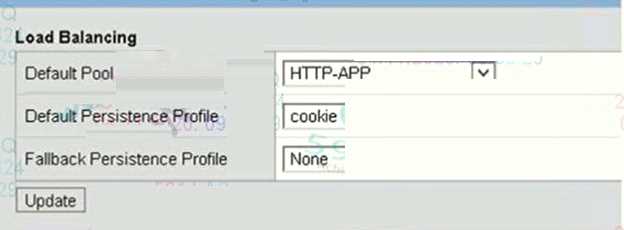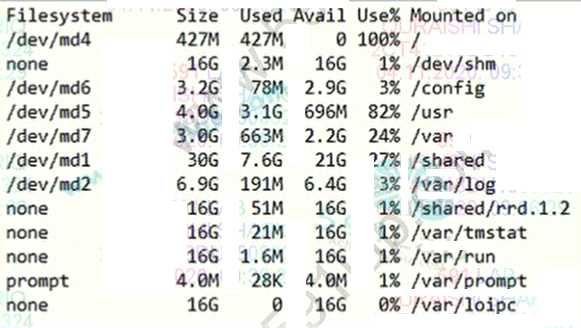f5 201 practice test
TMOS Administration
Question 1
A Virtual Server uses an iRule to send traffic to pool members depending on the URI. The BIG-IP
Administrator needs to modify the pool member in the iRule.
Which event declaration does the BIG-IP Administrator need to change to accomplish this?
- A. CLIENT_ACCEPTED
- B. HTTP_RESPONSE
- C. HTTP_REQUEST
- D. SERVER_CONNECTED
Answer:
C
Explanation:
According to the UR! distribution is the category of HTTP requests, need to trigger HTTP_REQUEST
event.
Question 2
Refer to the exhibit.

A BIG-IP Administrator creates a new Virtual Server to load balance SSH traffic. Users are unable to
log on to the servers.
What should the BIG-IP Administrator do to resolve the issue?
- A. Set Protocol to UDP
- B. Set HTTP Profile to None
- C. Set Source Address to 10.1.1.2
- D. Set Destination Addresses/Mask to 0.0.0.0/0
Answer:
B
Question 3
A BIG-IP Administrator uses backend servers to host multiple services per server. There are multiple
virtual servers and pools defined, referencing the same backend servers.
Which load balancing algorithm is most appropriate to have an equal number of connections on each
backend server?
- A. Least Connections (member)
- B. Least Connections (node)
- C. Predictive (member)
- D. Predictive (node)
Answer:
B
Explanation:
The same set of servers provides multiple services, that is, using different ports to provide different
services at the same time. The stem requirement is based on server connection balancing, not server
+ port, so it is node.
Question 4
The BIG-IP Administrator needs to perform a BIG-IP device upgrade to the latest version of TMOS.
Where can the administrator obtain F5 documentation on upgrade requirements?
- A. AskF5
- B. DevCentral
- C. Bug Tracker
- D. iHealth
Answer:
A
Question 5
A BIG-IP Administrator makes a configuration change to the BIG-IP device. Which file logs the
message regarding the configuration change?
- A. /var/log/messages
- B. /var/log/audit
- C. /var/log/user.log
- D. /var/log/secure
Answer:
B
Explanation:
About audit logging
Audit logging is an optional feature that togs messages whenever a BIG-IP® system object, such as a
virtual server or a load balancing pool, is confined (that is. created, modified, or deleted). The BiGIP
system logs the messages for these auditing events in the file /var/log'audit
There are three ways that objects can be configured
• By user action
• By system action
• By loading configuration data
Whenever an object is configured in one of these ways, the BIG-IP system logs a message to the
audit log
Question 6
In the BIG-IP Configuration Utility, a user requests a single screen view to determine the status of all
Virtual Servers and associated pool members, as well as any iRules in use. Where should the BIG-IP
Administrator instruct the user to find this view?
- A. Local Traffic > Monitors
- B. Local Traffic > Virtual Servers
- C. Local Traffic > Network Map
- D. Statistics
Answer:
C
Explanation:
Network Map can display vs and its associated pool, pool member, and irule, can be retrieved, and
can be quickly linked.
Question 7
What is the status of a pool member when manual resume is enabled and a health check first fails
and then passes?
- A. Offline (Disabled)
- B. Offline (Enabled)
- C. Available (Disabled)
- D. Available (Enabled)
Answer:
A
Question 8
Some users who connect to a busy Virtual Server have connections reset by the BIG-IP system. Pool
member resources are NOT a factor in this behavior. What is a possible cause for this behavior?
- A. The Connection Rate Limit is set too high
- B. The server SSL Profile has NOT been reconfigured.
- C. The Connection Limit is set too low.
- D. The Rewrite Profile has NOT been configured.
Answer:
C
Explanation:
The topic explains that the connection reset behavior is caused by the vs configuration rather than
the server resource problem. The answers B C are all configuration at the service forwarding level. If
there is a problem with the configuration, it is all a problem rather than some users. Answer C's
Connection Limit will cause a reset behavior when the connection reaches the threshold.
Question 9
New Syslog servers have been deployed in an organization. The BIG-IP Administrator must
reconfigure the BIG-IP system to send log messages to these servers.
In which location in the Configuration Utility can the BIG-IP Administrator make the needed
configuration changes to accomplish this?
- A. System > Logs > Configuration
- B. System > Configuration > Local Traffic
- C. System > Logs > Audit
- D. System > Configuration > Device
Answer:
A
Question 10
A BIG-IP Administrator needs to restore a UCS file to an F5 device using the Configuration Utility.
Which section of the Configuration Utility should the BIG-IP Administrator access to perform this
task?
- A. Local Traffic > Virtual Servers
- B. Local Traffic > Policies
- C. System > Archives
- D. System > Configuration
Answer:
C
Question 11
Refer to the exhibit.
Due to a change in application requirements, a BIG-IP Administrator needs to modify the
configuration of a Virtual Server to include a Fallback Persistence Profile.
Which persistence profile type should the BIG-IP Administrator use for this purpose?
- A. SSL
- B. Hash
- C. Universal
- D. Source Address Affinity
Answer:
D
Question 12
A BIG-IP device sends out the following SNMP trap:
big-ipo.f5.com - bigipExternalLinkChange Link: 1.0 is DOWN
Where in the BIG-IP Configuration utility should the BIG-IP Administrator verify the current status of
Link
1.0?
A. System > Platform
B. Network > Trunks > Trunk List
C. Statistics > Performance > System
D. Network > Interfaces > Interface List
Answer:
D
1.0 is a physical interface, you can see the interface status from the physical interface in the network.
Question 13
Refer to the exhibit.
The BIG-IP Administrator is investigating disk utilization on the BIG-IP device.
What should the BIG-IP Administrator check next?
- A. Large files on the / file system
- B. Results from the EUD test
- C. Results from the platform diagnostics test
- D. Large files on /usr file system
Answer:
A
Question 14
Which Virtual Server type prevents the use of a default pool?
- A. Performance (Layer 4)
- B. Forwarding (IP)
- C. Performance HTTP
- D. Standard
Answer:
B
Explanation:
Forwarding (IP) cannot be associated with the pool.
Question 15
A BIG-IP Administrator needs to view the CPU utilization of a particular Virtual Server. Which section
of the Configuration Utility should the administrator use for this purpose?
- A. Statistics > Module Statistics > Local Traffic > Virtual Addresses
- B. Statistics > Module Statistics > Traffic Summary
- C. Statistics > Analytics > Process CPU Utilization
- D. Statistics > Module Statistics > Local Traffic > Virtual Servers
Answer:
D